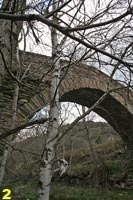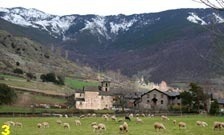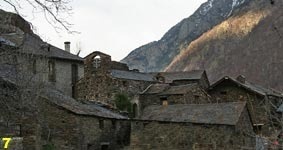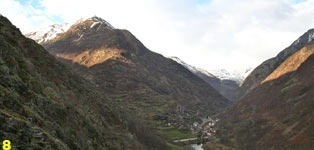The route we propose will traverse the Noguera de Cardós Valley, which is divided into three municipalities: Vall de Cardós, created in the early 1970s with the merger of Estaón and Ribera de Cardós, Esterri de Cardós, and Lladorre. These sparsely populated areas are primarily dedicated to agricultural and livestock activities, but have recently been subject to significant urban development pressures. This route will introduce us to churches of singular importance and medieval bridges over the Noguera de Cardós Valley, both excellently preserved and restored.
We'll start in the town of Ribera de Cardós, where the church of Santa Maria is located (photo 1). We continue north. The road approaches the river again, and before reaching Cassibrós, we'll find the Romanesque bridge that crosses it on the right (photo 2). We won't leave the L-504 until we pass Ainet de Cardós, where the road to Esterri de Cardós and Ginestarre emerges on the right. In photo 3, we can see Arròs de Cardós in the foreground and Esterri in the background.
Esterri de Cardós (photo 4) is located at an altitude of 1,212 meters. The Romanesque church of Sant Pau i Sant Pere is located at the edge of the village, next to the road that climbs toward Ginestarre, a town already at an altitude of 1,364 meters and home to the Romanesque church of Santa Maria (photo 5). The latter will soon gain in interest, as the original Romanesque paintings currently housed at the MNAC will be accurately reproduced thanks to the new gel-paper technique, which offers excellent results, as we were able to see in Castell de Mur.

To continue the route, we'll have to return to the L-504 and head north again, to the town of Lladrós. Shortly after this, a path to our right leads to the Romanesque bridge (photo 6) that crosses La Noguera de Cardós next to the chapel of Our Lady of the Bridge. It's a good idea to take this path because parking on the main road is almost impossible. There's usually space next to the chapel, not much, but enough to avoid disturbing the few tractors that pass by.
We're almost at the bottom of the valley. The road continues to the winter resort of Tavascan, but before that, to the left, a narrow branch (photo 8) ascends to the small town of Aineto, where the small church of Sant Romà (photo 7) is located, reminiscent of the rural churches of Andorra. Our last visit will be the Tavascan Bridge, which spans the river of the same name and connects the two neighborhoods of this small tourist town in the Pyrenees.
Source: Romanesque on the road
Link: http://ow.ly/k3RoJ







